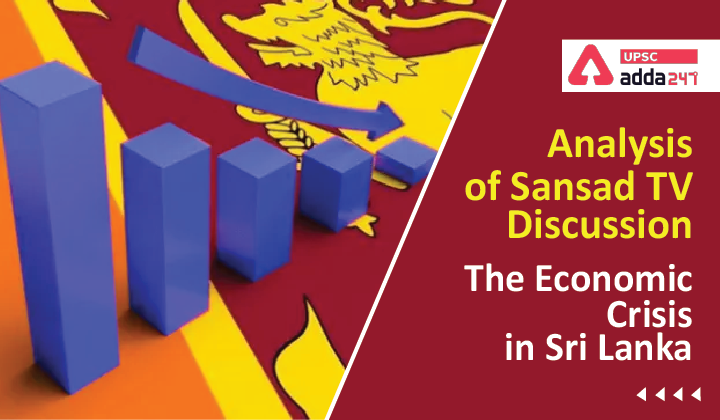Table of Contents
Analysis Of Sansad TV Discussion: ”The Economic Crisis in Sri Lanka”
Relevance
GS 2: Effect of Policies & Politics of Countries on India’s Interests, India and its Neighbourhood
Introduction
- Sri Lanka is passing through an acute economic crisis due to depletion in foreign reserves which in turn has resulted in shortages of fuel, food, medicines, cement and other essential items in the country.
- With long lines for fuel, cooking gas, essentials in short supply and long hours of power cuts, the public has been suffering for months.
- The raging public anger in Sri Lanka last week led to nationwide protests and a subsequent declaration of public emergency in the island nation by President Gotabaya Rajapaksa.
How Sri Lanka is facing Economic cum Political Crisis?
- The President removed his brother and Finance Minister Basil Rajapaksa from his post.
- Facing the heat from public, all Cabinet ministers resigned.
- The new finance minister Ali Sabry resigned – just a day after being sworn in.
- The ruling coalition, headed by President Gotabaya Rajapaksa, lost its majority in Parliament as proceedings began on Tuesday for the first time since the state of Emergency was imposed.
- At least 41 lawmakers walked out of the alliance against the backdrop of nationwide protests.
What is wrong with Sri Lanka’s foreign reserve?
- Since its independence, the trade deficit has been a consistent feature of Sri Lankan economy, as its import bill has always been more than the revenue earned through export.
- A huge amount of the foreign exchange earned is being consumed to pay for the import bill for years.
- In recent years, the debt-servicing commitment of the government has put additional pressure on foreign reserves.
- As of February, the country was left with only $2.31 billion in its reserves but faces debt repayments of around $4 billion in 2022, including a $1 billion international sovereign bond (ISB) maturing in July.
- In a review of the country’s economy released last month, the IMF said that public debt had risen to “unsustainable levels” and foreign exchange reserves were insufficient for near-term debt payments.
Key Reasons Behind Sri Lanka’s Economic Crisis
Shortage of foreign reserves
- The economic mismanagement of successive governments has depleted 70 per cent of Sri Lanka’s foreign reserves with only $2.31 billion left with debt repayment of over $4 billion.
- Sri Lanka’s high dependency on imports for essential items like sugar, pulses, and cereals adds fuel to the economic meltdown as the island nation lacks foreign reserves to pay for its import bills.
The pandemic effect
- The island nation’s huge dependence on tourism and foreign remittances was sapped by the COVID-19 pandemic that set the pretext for the current crisis.
- Tourism, which accounts for over 10 per cent of the Sri Lankan GDP, was hurt after it lost visitors from three key countries: India, Russia and the UK.
Russia-Ukraine war-induced inflation
- The ongoing Russia-Ukraine war resulted in steep price inflation of crude oil, sunflower oil and wheat.
- Crude oil prices hit a record high in 14 years with prices soaring over $125/barrel at the height of the crisis.
- India had to step in by supplying 40,000 MT of diesel under a promised $500 million line of credit. India has so far supplied over 2,00,000 MT of fuel in the last 50 days.
Agri sector crisis
- The Rajapaksa government’s decision to ban all chemical fertilizers last year to make agriculture 100 per cent organic severely hit the country’s farm production, especially in rice and sugar production forcing the reversal of this decision.
Sharp fall in FDI
- According to government data, FDI stood at $548 million in 2020 compared to $793 million and $1.6 billion in 2019 and 2018, respectively.
Is Sri Lanka a Classic Twin Deficit Economy?
- Sri Lanka is a classic twin deficits economy,” said a 2019 Asian Development Bank working paper.
- Twin deficits signal that a country’s national expenditure exceeds its national income, and that its production of tradable goods and services is inadequate.
Measures Taken by Sri Lankan Government
Import Restrictions: The Sri Lankan government has banned import of luxury vehicles, chemical fertilisers and food items like turmeric to prevent foreign currency outflows.
Restrictions on forward contracts of foreign exchange: In view of the need to avoid excess volatility in the foreign exchange market, the CBSL has directed the licensed commercial banks to refrain from entering into forward contracts of foreign exchange for a period of three months.
Enhancing Remittance Inflow: To enhance remittance inflows to the country, the government has introduced several policy initiatives like: proposal to diversify the foreign employment market which is now mostly dependent on the Middle Eastern countries; establishing a contributory pension scheme for migrant employees.
Assistance from Bilateral Partners: Government of Sri Lanka is approaching bilateral partners for assistance to deal with the current economic crisis in the form of loans and currency swap facilities.
Boosting investors’ confidence: To boost investors’ confidence, the government has made provisions for Special Deposit Accounts.
No to International Monetary Fund (IMF) Bailout: Sri Lanka is not keen to approach IMF for bailout, as the IMF assistance comes with strings attached, which would impose additional burden on the people who are already facing challenges due to the pandemic and the ongoing economic crisis, according to the government.



 TSPSC Group 1 Question Paper 2024, Downl...
TSPSC Group 1 Question Paper 2024, Downl...
 TSPSC Group 1 Answer key 2024 Out, Downl...
TSPSC Group 1 Answer key 2024 Out, Downl...
 UPSC Prelims 2024 Question Paper, Downlo...
UPSC Prelims 2024 Question Paper, Downlo...





